Preprint
Article
Measurements on Micro-Vibration in a Production Workshop with Precision Instruments Induced by Road Traffic
Altmetrics
Downloads
86
Views
34
Comments
0
This version is not peer-reviewed
Submitted:
29 September 2023
Posted:
30 September 2023
You are already at the latest version
Alerts
Abstract
Road traffic transportation has flourished in the process of urbanization by its advantages, but it also produces harmful environmental vibrations. The vibration problem is especially significant for production workshops with precision instruments. A field measurement was conducted to analyze the source characteristics and propagation laws of traffic-induced vibrations. Off the northern side of an urban highway lies a microelectronics workshop. When a large truck passes by, both the vibration responses on the ground and in the workshop considerably increase. Greater vibration is produced in the vertical direction than in the X and Y axes. The predominant frequency band of the vibration response caused by road traffic vehicles is lower than 20 Hz. The vertical vibration responses of the first and second floors in the workshop greatly exceed the VC-C limit because of the high daily traffic flow. Attribute to the excitation of the operation of the manufacturing equipment on the second floor, the vertical vibration level of the second floor is essentially higher than that of the first floor. Therefore, it is impossible to disregard the micro-vibration in the workplace produced by the manufacturing machinery as well as the ex-citement of the road traffic. The measured data can be used to test potential numerical models for forecasting vibrations caused by traffic on roads as well as to guide vibration assessment work throughout the planning and design stages of roads.
Keywords:
Subject: Engineering - Civil Engineering
1. Introduction
With the improvement of the urbanization rate in China, the population is gathering in the cities, and the urban road network system has also been upgraded [1,2]. The well-connected traffic network has brought a lot of convenience to people's lives and traveling. However, with the distance between the roads and the buildings shrinking, many adverse effects on the building structure and the normal work of the precision instruments have resulted in road traffic [3,4,5]. The vibration hazard caused by road traffic becomes an urgent social and engineering problem to be solved [6,7,8].
As for the vibration propagation characteristics caused by road vehicles running, Watts [9] found that significant vibration responses could be observed within 50 meters from the center of the road when heavy vehicles were running on an uneven road. In theoretical investigations, a simplified vibration prediction model was proposed to consider the influence of factors such as vehicle speed, vibration propagation distance, and the maximum height and depth of the uneven pavement on the road [10]. Hunt [11,12] and Lombaert [13] assumed that the effect of running vehicles on the road was a steady-state process. In their studies, the vehicle was simplified into different models, and the influence of different road surfaces on the vibration caused by the vehicle was discussed. An analytical method based on random vibration analysis was proposed to predict the power spectral density of traffic-induced ground-borne vibration by Hao and Ang [14], which showed that the ground-borne vibration was mainly caused by the propagation of the Rayleigh wave. Other numerical models were established to study the vibration response caused by the running vehicle on roads with different roughness [15,16]. In Lak’s study [16], the load weight, traffic degree, and road roughness were significant factors that affected the environmental vibration caused by road traffic. However, the pavement structure primarily affected the near-field vibration response in a high-frequency band, and the road-soil transfer function was mainly determined by soil parameters so the accurate identification of soil dynamic parameters was the key to predicting traffic-induced environmental vibration issues. Road humps and speed cushions were used to control vehicle speeds in specific areas. Whereas, obvious vibrations were produced when vehicles passed over these speed bumps and in some cases, they could reach perceptible levels in adjacent buildings [17]. A theoretical analysis model was established to study the subject of vehicles passing over speed bumps, and influences of the vehicle speed, tire stiffness, and the height and width of the unevenness were discussed [18]. Many valuable findings have been obtained from the above theoretical analysis and numerical simulation.
However, any theoretical analysis and numerical simulation cannot consider all objective factors. Prediction uncertainties and inaccuracies resulting from assumptions in modeling cannot be neglected. The site experiment is the most intuitive and accurate means to study the vibration source excitation and the response of sensitive targets when the vehicle passes, and it is also the most rigorous way that check and evaluate analytical and numerical solutions. A large number of field experiments have been carried out in academic and engineering fields to provide accurate model parameters and test data to validate theoretical models [19,20,21,22,23,24,25].
To verify the numerical model of environmental vibration, a field experiment was performed by Mhanna et al. [19]. Test vehicles were used in another field test carried out by Taniguchi and Sawada [20]. It was found that the Rayleigh wave played a primary role in the vibration propagation, and its dominant frequency range was located at 10~20 Hz. The field vibration responses induced by different types of vehicles traveling at different speeds were measured, and it was observed that the vibration responses mainly dominated in 10~40 Hz, and the vibration frequency induced by buses was concentrated in the relatively narrow frequency band of 10~12.5 Hz [21]. A detailed field measurement of the environmental vibration caused by road traffic in Montreal was conducted, and it was observed that the dominant frequency band of vibration caused by trucks was concentrated between 10 and 20 Hz [22]. Another field test was executed to study the vibration response of the free field beside the two-way subway line and the road traffic, and the different characteristics of vibration induced by the subway trains and road vehicles were discussed [23]. To find out the influence of road traffic on ancient buildings, an experimental study on the vibration of ancient buildings caused by road traffic vehicles was performed [24]. The vibration response caused by the vehicle passing through different types of deceleration devices was researched using experiments [25]. It is observed that obvious frequency characteristics of road traffic-induced environmental vibration have been figured out in the above-mentioned studies.
Whereas, most of the experimental studies mainly focused on the vibration problems with intensive vibration levels, and relatively little attention was paid to the impact of micro-vibration. With the development of the social industrialization process, the problem of micro-vibration is gradually exposed [26,27,28]. For workshops with precision instruments and optical equipment, micro-vibration may affect the image resolution of instruments and the production capacity of precision equipment.
In this study, the micro-vibration field test was carried out for the production workshop of microelectronics enterprises adjacent to an urban expressway in Xiamen, China. Based on the geotechnical engineering investigation, the test site belongs to the remnant mound area. The stratum is mainly composed of quaternary eluvial soil and slightly weathered bedrock. According to its occurrence form, groundwater can be divided into weathered eluvial pore fissure water and bedrock fissure water. Special attention is paid to the site vibration on the ground and the micro-vibration inside the production workshop due to road traffic. To gain a better understanding of such a complex dynamic system, the measurement data are analyzed both in the time and frequency domains, and the test results can provide references for similar research.
2. Field Test Site and Experiment Scheme
2.1. Field Test Site
The microelectronics enterprise is constructed off the northern side of an urban expressway in Xiamen, China, as shown in Figure 1a, of which the No. 3 production workshop has been built and put into operation. It is a high-tech workshop for the production of new-type displays, which is equipped with submicron (25~1.0 μm) precision instruments for production. The distance from the edge of the urban expressway to the production workshop is about 82 m. There are six lanes in both directions for the main carriageway of the urban expressway. And for the auxiliary carriageway, there are four lanes in both directions. The design speed of the expressway is 80 km/h. To the southwest of the No. 3 production workshop, the nearest distance from the workshop to the elevated rail transit line is about 65 m, see Figure 1a.
The overall length and width of the No. 3 production workshop are 507.9 m×252.6 m, with a building height of about 26 m. There is no production equipment in the dust-free room on the first floor of the workshop, which is used as a ventilation space. The core area in the workshop is on the second floor. There are many fully automated production equipment on the second floor, which operate continuously for 24 hours. Therefore, the vibration sources for the precision instruments in the workshop mainly include (1) vibration generated by the operation of machinery and equipment in the production workshop; (2) vibration of air conditioning and ventilation equipment in the dust-free room; (3) instantaneous shock and vibration caused by personnel walking; (4) vibration from the nearby construction site; (5) vibration caused by running vehicles on the road in the factory area and urban roads outside the factory area.
2.2. Measurement Scheme
Since the environmental vibration caused by road traffic belongs to low-frequency vibration, the vibration attenuation rate is slow during the process of propagation. Micro-vibration is one of the key issues to be considered and solved in the production process of the display screen. At the same time, the elevated rail transit line under planning may also have a significantly adverse impact on the normal production activities in the No. 3 production workshop after it is put into operation. At present, the primary task is to find out the micro-vibration level of the No. 3 workshop and the significant influence factors under the existing vibration sources. Therefore, three test sections were arranged in different areas of the No. 3 workshop. Meanwhile, to find out the attenuation characteristics of vibration on the propagation path, the test section 4 # is set on the transmission route between the test section 3 # and the expressway. The four test sections are all within the green dotted circle in Figure 1a, which is illustrated in Figure 1b in detail.
The layout of test points for the 4 test sections is shown in Figure 1c. The test sections 1 #, 2 #, and 3 # were located in the workshop. Each test section contained 8 measuring points, of which measuring points 1 # to 4 # were arranged on the first floor, and measuring points 5 # to 8 # were installed on the second floor, and the intervals between the measuring points were 20 m. The test section 4 # was located on the transmission path between the urban expressway and the workshop. Seven measuring points of test section 4 # were arranged on the ground. The measuring point 4-1 # was installed next to the urban expressway, the intervals between the adjacent measuring points 4-1 # to 4-6 # are 10 m, and the distance between the measuring points 4-6 # and 4-7 # is 15 m. Each measuring point of the 4 test sections was equipped with 3 sensors to record the vibration speed in X, Y, and Z directions shown in Figure 1c.
Based on the Technical Specifications for Environmental Vibration Monitoring (Draft for Comments) in China, the monitoring of the regional environmental vibration is divided into two periods: daytime and nighttime monitoring. Daytime refers to the period between 6:00 a.m. and 10:00 p.m. in one day, and nighttime refers to the period from 10:00 p.m. to 6:00 a.m. on the next day. The time interval between the two tests is one hour. According to the above-mentioned specifications, micro-vibration monitoring in workshop No. 3 was carried out on test sections 1 #, 2 #, and 3 # for 24 hours, respectively, and the monitoring was performed each hour with a duration of 10 minutes. The measurement was conducted for test section 4 # in the period between 7:30 p.m. and 8:30 p.m. when a large number of vehicles were running on the urban expressway. 35 groups of data have been collected, and the duration of each data collection was 30 s.
For the test sections 1#, 2#, and 3 # in the No.3 workshop, sensors were installed on the first and second floors of the building. The dust-free room on the first floor has no production equipment, and the sensors were directly installed on the first-floor slab, as shown in Figure 2. The core production area was on the second floor, and the production equipment was placed on the waffle board. When installing the sensors on the second-floor slab, the waffle board needed to be removed first, and the sensors shall be installed on the floor slab under the waffle board. The second floor was equipped with ventilation holes, and the sensors shall be installed on the floor beside the ventilation hole, as shown in Figure 3. In Figure 3, test sections 1 # and 2 # on the second floor were located in the yellow light area, and the surrounding production equipment was dense, test section 3 # was located in the white light area, which with the fewest equipment of the three test sections.
The measuring points of test section 4 # were placed on the ground between the urban expressway and the workshop. The surface of the green belt is covered with weeds and low trees. The installation procedure for the sensors is shown in Figure 4. Firstly, the surface floating soil needed to be removed, and a square foundation pit was excavated to place a square steel plate with an L-shaped angle steel and four small holes at the four corners. Then, four steel drills were inserted into the soil through the holes to fix the plate. Finally, sensors were mounted on the steel plate in the X, Y, and Z directions.
891 type II low-frequency accelerometers were used in the experiment. The measurement range is 0 to 4 g with an effective frequency range of 0.5 Hz to 80 Hz. The data acquisition system used in the measurement is INV3060S. The sampling frequency is 1024 Hz. Random sampling was conducted beside the road. About 3 to 5 heavy trucks passed by per minute in one direction. The traffic condition on the expressway is shown in Figure 5.
3. Vibration on the Transmission Route
The site of the transmission route between the road and the workshop belongs to the remnant mound area and the stratum is mainly composed of quaternary eluvial soil. Characteristics of vibration propagation in the geology condition are analyzed in time and frequency domains.
3.1. Time History Analysis
Without vehicles running on the road, the background vibration responses on the ground are really small, and their discrepancies between different measuring points are also tiny. With the excitation of road traffic vehicles running, the vibration responses on the ground increase to some extent, and while the heavy vehicles pass by, the ground-borne vibration responses magnify significantly. The vibration responses of the measuring points decrease gradually with the increase of the distance from the road. Figure 6 shows the time histories of velocity responses in the vertical, X, and Y directions at locations 4-1 #, 4-5 #, and 4-7 #.
The comparison of time histories in the three directions in Figure 6 shows that the vertical vibration response is the largest and the vibration response in the Y direction is the smallest. In Figure 6, both the background vibration and traffic-induced vibration can be observed in response to the three directions. Responses in the period of 0 s to 7 s show the background vibration, but the response at each measuring point is relatively tiny, and the differences in responses between different measuring points are slight as well.
Vibration responses of the ground measurement points in the periods of 7 s to 23 s and 27 s to 30 s are generated by the passage of the road vehicles except for heavy trucks, which is greater than that of the background vibration. The vibration response in 23 seconds to 27 seconds increases significantly due to the passage of heavy trucks. And the closer to the road it is, the more the vibration response increases. From Figure 6a, the peak response caused by heavy vehicles passing by can be observed at locations 4-1 # and 4-5 #, corresponding to 23.77 s and 24.48 s respectively, from which the time lag phenomenon can be observed.
3.2. FFT Spectrum Analysis
The dominant frequency band of ground-borne vibration in the vertical, horizontal X, and Y directions caused by road traffic is concentrated within 20 Hz. The peak frequency of the vertical vibration appears at 12 Hz, and the peaks of the horizontal vibration responses in the X and Y directions appear around 6 Hz and 12 Hz. During the propagation of vibration, the response amplitude gradually attenuates with the increase of distance from the road. The FFT spectra of vibration velocity in the vertical, horizontal X, and Y directions at locations 4-1 #, 4-3 #, 4-5 #, and 4-7 # are given in Figure 7.
It can be seen from Figure 7 that the vertical vibration amplitude is greater than those in the horizontal X and Y directions, and the vibration amplitude in the horizontal Y direction shows the smallest response, which is consistent with the analysis conclusion from Figure 6. The vibration responses in the three directions decrease gradually with the increase of the propagation distance.
3.3.1/3. Octave Spectrum
Based on the description in Section 2.2, 35 groups of test data were recorded for test section 4 # during the period of 7:30 p.m. to 8:30 p.m. when there were a large number of vehicles passing through the urban expressway. The duration of each test was 30 seconds. According to the 35 groups of test data, a 1/3 octave analysis was carried out. Due to the differences in the test data, a 95% confidence interval was employed for 1/3 octave spectra. The 95% confidence limits of vertical vibration responses at measuring points of 4-1, 4-3, 4-5, and 4-7 # are shown in Figure 8. It can be seen from Figure 8 that the dominant frequency band of the ground-borne vibration response is within 20 Hz, and the peak frequency of the vibrations at 4-1 # and 4-3 # is located at 10~20 Hz. With the increase of propagation distance, the peak frequency of the vibration responses at 4-5 # and 4-7 # shifts to 10 Hz, and the vibration amplitude decreases, especially evident in the dominant frequency band.
3.4. Vibration Level
To further investigate the ground-borne vibration induced by road traffic, the vibration is evaluated by use of the speed vibration level Lv in decibels, expressed as
where Lv is the velocity level in decibels, and Vms is the effective value (root mean square value) of vibration velocity in m/s, and Vref is reference velocity, of which the value is 2.54 × 10-8 m/s, according to the regulations of Department of Railway Transportation in the U.S. [29].
For 35 groups of test data, the vertical velocity vibration level Lv was calculated using Eq (1). Due to the differences that exist in the test data, a 95% confidence interval was employed, as shown in Figure 9. In Figure 9, the total vibration levels at all test points on the ground are exhibited. The vertical velocity vibration level decreases gradually with the increase of distance from the road, indicating that the vibration energy is gradually decreasing during the vibration propagation.
4. Vibration in the Workshop
The production workshop is located near the urban expressway. The road traffic-induced micro-vibration may affect the normal operation of the instruments and equipment in the workshop. Therefore, it is necessary to conduct a detailed study on the influence of road traffic on the workshop.
4.1. Time History Analysis
The road traffic-induced vibration in the workshop attenuates during the vibration propagation from the first floor to the second floor. The vibration of the second floor is significantly affected by the operation of the production equipment. The time histories of the vertical vibration velocity at locations 2-4 # and 2-8 # are shown in Figure 10. The test point 2-4 # is on the first floor, and 2-8 # is on the second floor.
It can be observed from Figure 10 that the response increases significantly during the period of 348 s to 354 s when heavy trucks pass by. However, the response amplitude of the second floor is smaller than that of the first floor in this period, which indicates that the traffic-induced vibration attenuates with the vibration propagation from the first floor to the second floor. Compared to the responses in the other periods (335 s to 348 s and 354 s to 365 s) in Figure 10a with b, it can be observed that the vibration amplitude of Figure 10b is greater than that of Figure 10a. Since the production equipment on the second floor operates continuously for 24 hours, the most likely reason for the increase of vibration on the second-floor slab in the periods of 335 s to 348 s and 354 s to 365 s is the vibration contribution due to the operation of production machinery and equipment.
4.2. FFT Spectrum Analysis
The peak frequency of workshop vibrations in the vertical caused by the road traffic is concentrated around 10 Hz. The vibration in this frequency range attenuates with the vibration propagation from the first floor to the second floor in the workshop. The vibration of the second-floor slab is affected by the excitation induced by the production equipment, which results in localized peaks in the frequency band above 20 Hz. FFT spectra of vibration velocity in the vertical direction at all locations of test section 2 # are shown in Figure 11.
For the vertical vibration response of the workshop in Figure 11, the FFT spectrum waveforms of the vibration response at the test locations on the first and second floors are similar, and the vibration peaks appear around 10 Hz. The vibration amplitude of the second-floor slab is smaller than that of the first-floor in frequencies around 10 Hz, suggesting that the dominant frequency range of road traffic-induced vibration is around 10 Hz, which is a coincidence with Refs. [20,21,22]. The traffic-induced vibration decreases when it is transmitted from the first floor to the second floor. In addition, the localized vibration peaks of the second floor can be observed at 30 Hz, 50~60 Hz, and 70~80 Hz in Figure 11b. The amplitudes of the localized vibration peaks are increased compared with Figure 11a, and the most likely reason for this phenomenon is the vibration effects generated by the operation of the equipment on the second floor.
4.3. 1/3. Octave Spectrum
For the normal operation of the sensitive equipment, the vibration at the placement position of the equipment is quite severe. There is a special vibration criterion for the evaluation of micro-vibration, which takes a 1/3 octave spectrum of the effective value of velocity as the evaluation index [30]. There are 7 vibration levels from VC-A to VC-G for the evaluation of micro-vibration, and the limit value is reduced step by step (VC-G has the most rigorous standard and the smallest vibration limit), shown in Figure 12. The detailed description can be found in Amick [31]. According to the precision requirements of the production equipment in this study, the vibration in the workshop needs to be kept within the VC-C limit.
On the second floor slab, the area of test section 2 # is densely equipped with production machinery, of which the vibration response is analyzed in detail to explore the vibration characteristics in the workshop. The 1/3 octave spectra of the vibration velocity at each measurement point in the vertical, horizontal X, and Y directions on the first and second floors are illustrated in Figure 13, Figure 14 and Figure 15, respectively. It can be found that the test results have obvious discreteness. The reasons mainly lie in two aspects. On one hand, vibrations of different measurement points caused by the equipment operation are different. On the other hand, random traffic flow on the expressway contributes to significant differences in vibration responses.
Figure 13a and b show 1/3 octave spectra of vertical vibration at the measuring points on the first and second floors in the daytime (6:00 a.m. to 10:00 p.m.), respectively, and the one in the nighttime (10:00 p.m. to 6:00 a.m. on the next day) has been given in Figure 13c and d. In the daytime, the vertical vibration response of the measuring points on the first and second floors far exceeds the VC-C limit in a wide frequency range. At night, some test conditions of the vertical vibration response on the first floor exceed the VC-C limit of around 6 Hz, while the vertical vibration response on the second floor in the peak frequency band of around 30 Hz and 80 Hz also exceeds the VC-C limit.
Considering the effects of the road vehicles, part of the test results show response peaks around 6 Hz in Figure 13a~d, and a larger response peak appears around 10 Hz in Figure 13a and b. The reason is primarily due to the large traffic flow and rapid passage of heavy vehicles during the daytime, resulting in a peak response near 10 Hz. While there is relatively less traffic flow and few heavy vehicles at night, no response peaks around 10 Hz are observed. In the frequency ranges around 30 Hz and 80 Hz, obvious vibration response peaks can be observed in Figure 13b and d, and response amplitudes are significantly higher than those in Figure 13a and c. This is likely due to the 24-hour uninterrupted operation of the production facilities on the second floor. So for the daytime and nighttime, no significant differences in vibration responses around 30 Hz and 80 Hz are observed in Figure 13b and d. It can be seen from Figure 13d that the vibration generated by the operation of the production facilities at night even exceeds the contribution of road vehicles to the vibration on the second-floor slab.
1/3 octave spectra of vibration in the X direction at the measuring points on the first and second floors during the daytime have been illustrated in Figure 14a and b, and the one in the nighttime has been given in Figure 14c and d. The X-direction vibration response of test section 2 # in the production workshop is smaller than that in the vertical direction. In the daytime, only a few test data on the first and second floors exceed the VC-C limit in the peak frequency band. At night, the vibration responses on the first floor are very small, and all of them fail to reach the VC-C limit. And X-direction vibration responses on the second floor are only greater than the VC-C limit in the peak frequency band around 80 Hz.
1/3 octave spectra of vibration in the Y direction at the measuring points on the first and second floors during the daytime have been indicated in Figure 15a and b, and the one in the nighttime has been given in Figure 15c and d. The Y-direction vibration response of test section 2 # is similar to the vibration in the X-direction, and much smaller than that in the vertical direction. In the daytime, very few test data on the first floor exceed the VC-C limit in the peak frequency ranges around 10 and 50 Hz, and vibrations on the second floor only exceed the VC-C limit at the peak frequency of 80 Hz. At night, only individual data on the first floor exceed the VC-C limit at the peak frequency of 50 Hz, while partial vibration responses on the second floor exceed the VC-C limit at 30 and 80 Hz.
4.4. Vibration Level
To study the vibration level of the first- and second-floor slabs in the workshop at different moments, Eq. (1) is used to solve the velocity vibration level of the responses in the workshop. The mean and standard deviation of the vibration levels at the four measurement points on the same floor are solved respectively. Taking test section 1 # as an example, the mean and standard deviation of the vibration response on the first floor are calculated according to the responses of the measuring points 1-1 # to 1-4 #, and the mean value and standard deviation of the responses on the second floor are obtained according to the responses of the measuring points 1-5 # to 1-8 #. The mean and standard deviation of vibration responses on the first and second-floor slabs at the three test sections in the workshop are shown in Figure 16.
Shown as in Figure 16, the square and circle dots represent the means of the vibration responses, and the vertical short line represents the standard deviation of the vibration responses. It can be seen from Figure 16 that the mean value and standard deviation of the vibration levels in the workshop have obvious variations at different moments, mainly due to the random road traffic flow on the expressway. However, it can be observed that the mean values of the vibration level magnify with the increased traffic flow in the morning and evening peak periods. During the three days when the three test sections were measured respectively, the morning peak periods were uniform, which appeared in the period of 8:00 a.m. to 9:00 a.m., while the evening peaks primarily appeared in the period of 7:00 p.m. to 9:00 p.m.
Comparing the vibration characteristics of the first and second-floor slabs at the three test sections, it can be found that the velocity vibration level of the second-floor slab is greater than that of the first-floor slab, which is due to the vibration excitation caused by the operation of production facilities on the second floor. However, during the morning and evening peak periods, due to the increase of the road traffic flow, the contribution of vibration induced by road traffic increases, and the differences in vibration levels between the first and second floors decrease. It is even observed in Figure 16a that the vibration level on the first-floor slab exceeds that on the second-floor slab due to the dominant increase of road traffic flow during the morning and evening peak periods. Because of the heavy traffic flow during the morning and evening peaks, it is necessary to take measures to control the vibration response caused by running vehicles, such as limiting the load capacity of heavy vehicles, controlling the vehicle speed, improving the pavement grade, and reducing the pavement roughness.
5. Conclusions
Field measurements concerning traffic-induced vibration on the ground and a nearby 4-story workshop building in Xiamen, China, have been presented. The test site belongs to a remnant mound area and the stratum is mainly composed of quaternary residual soil. The production workshop has already been officially put into operation. Therefore, the vibration response in the workshop is also affected by the excitation of the equipment operation. The aim is to fully understand the propagation laws of traffic-induced vibration on the ground and vibration characteristics in the workshop induced by the road traffic and the running machinery. Four test sections were set up based on the main vibration sources.
The ground-borne vibration increases significantly when a heavy vehicle passes by. The vertical vibration response is greater than those in the horizontal X and Y directions, and the vibration in the Y direction has the smallest amplitude. The dominant frequency band of the ground-borne vibration caused by road traffic is concentrated within 20 Hz. The ground-borne vibration decreases with the increment of the distance from the road.
Inside the 4-story workshop building, the peak frequency of the vibration responses in the three directions caused by the road traffic is concentrated around 10 Hz, and vibration in this frequency range is attenuated with the vibration propagation from the first floor to the second floor. The peaks of vibration responses induced by the operation of production equipment on the second floor are located in the frequency range above 20 Hz, which is different from the road traffic-induced vibration.
In the daytime, the vertical vibration responses on the first and second floors in the workshop far exceed the VC-C limit, but only a few test conditions of the vibration responses in the horizontal X and Y directions exceed the VC-C limit in the peak frequency range. At night, only individual test conditions of the vibration responses on the first and second floors exceed the VC-C limit in the peak frequencies.
For the periods of morning and evening peaks with heavy road traffic flow, the vertical vibration responses on the first and second floors in the workshop increase significantly. However, the vertical vibration level on the second floor is greater than that on the first floor, which is caused by the excitation of the operation of the production equipment on the second floor.
Due to the heavy traffic flow in the daytime, the vertical vibration response of the floor slab in the workshop can easily exceed the VC-C limit. In addition, the vibration generated by the operation of the production equipment in the workshop cannot be ignored, which in turn has an obvious impact on the normal running of the production equipment. Therefore, it is necessary to explore the vibration reduction measures for the production equipment. Moreover, according to the metro line planning, there will be an elevated metro line located 65 m away from the workshop, which would have adverse impacts on the workshop after it is completed and put into operation. It is necessary to study the impacts of vibration induced by the subway line further.
Author Contributions
Conceptualization, Z.Z. and X.L.; methodology, X.L.; investigation, Z.Z. and X.Z.; writing—original draft preparation, Z.Z. and G.X.; writing—review and editing, Z.Z., X.L. and X.Z.; visualization, A.W. All authors have read and agreed to the published version of the manuscript.
Funding
This research was funded by the National Natural Science Foundation of China (Grant No. 52008123 and 52368059), and the Startup Project for High-Level Talents of Guizhou Institute of Technology (No. XJGC20190651).
Data Availability Statement
All the data are available within the manuscript.
Acknowledgments
Thanks are extended to the anonymous reviewers whose suggestions improved this manuscript.
Conflicts of Interest
The authors declare no conflict of interest.
References
- Khajehdezfuly, A.; Shiraz, A.A.; Sadeghi, J. Assessment of vibrations caused by simultaneous passage of road and railway vehicles. Appl Acoust. 2023, 211, 109510. [Google Scholar] [CrossRef]
- Li, Z.; Cao, Y.M.; Ma, M.; Xiang, Q. Prediction of ground-borne vibration from random traffic flow and road roughness: Theoretical model and experimental validation. Eng Struct. 2023, 285, 116060. [Google Scholar] [CrossRef]
- Czech, K.R. The Impact of the Type and Technical Condition of Road Surface on the Level of Traffic-Generated Vibrations Propagated to the Environment. Procedia Engineering. 2016, 143, 1358–1367. [Google Scholar] [CrossRef]
- Hao, H.; Ang, T.C.; Shen, J. Building vibration to traffic-induced ground motion. Build Environ. 2001, 36, 321–336. [Google Scholar] [CrossRef]
- Guo, M.D.; Ni, M.Y.; Shyu, R.; Ji, J.S.; Huang, J. Automated simulation for household road traffic noise exposure: Application and field evaluation in a high-density city. Computers, Environment and Urban Systems. 2023, 104, 102000. [CrossRef]
- Ertugrul, O.L.; Ozkan, M.Y.; Ulgen, D. Attenuation of traffic induced ground borne vibrations due to heavy vehicles. In Fifth International Conference on Recent Advances in Geotechnical Earthquake Engineering and Soil Dynamics and Symposium in Honor of Professor I. M. Idriss, 2010.
- Hajek, J.J.; Blaney, C.T.; Hein, D.K. Mitigation of highway traffic-induced vibration. In Annual Conference of the Transportation Association of Canada, 2006.
- Hu, Z.H; Tian, L.; Zou, C.; Wu, J. Train-induced vibration attenuation measurements and prediction from ground soil to building column. Environ Sci Pollut R. 2023, 30, 39076–39092. [Google Scholar] [CrossRef] [PubMed]
- Watts, G.R. Traffic-induced ground-borne vibrations in dwellings. Transport and Road Research Report, 1987.
- Watts, G.R. The generation and propagation of vibration in various soils produced by the dynamic loading of road pavements. Journal of Sound & Vibration. 1992, 156, 191-206. [CrossRef]
- Hunt, H. Modelling of road vehicles for calculation of traffic-induced ground vibration as a random process. Journal of Sound & Vibration. 1991, 144, 41-51. [CrossRef]
- Hunt, H. Stochastic modelling of traffic-induced ground vibration. Journal of Sound Vibration. 1991, 144, 53–70. [Google Scholar] [CrossRef]
- Lombaert, G.; DeGrande, G. The experimental validation of a numerical model for the prediction of the vibrations in the free field produced by road traffic. Journal of Sound & Vibration. 2003, 262, 309-331. [CrossRef]
- Hao, H.; Ang, T.C. Analytical Modeling of Traffic-Induced Ground Vibrations. J Eng Mech. 1998, 124, 921–928. [Google Scholar] [CrossRef]
- Agostinacchio, M.; Ciampa, D.; Olita, S. The vibrations induced by surface irregularities in road pavements –a Matlab® approach. Eur Transp Res Rev. 2014, 6, 267–275. [Google Scholar] [CrossRef]
- Lak, M.A.; Degrande, G.; Lombaert, G. The effect of road unevenness on the dynamic vehicle response and ground-borne vibrations due to road traffic. Soil Dyn Earthq Eng. 2011, 31, 1357–1377. [Google Scholar] [CrossRef]
- Watts, G.R.; Krylov, V.V. Ground-borne vibration generated by vehicles crossing road humps and speed control cushions. Appl Acoust. 2000, 59, 221–236. [Google Scholar] [CrossRef]
- Ducarne, L.; Ainalis, D.; Kouroussis, G. Assessing the ground vibrations produced by a heavy vehicle traversing a traffic obstacle. Sci Total Environ. 2018, 612, 1568–1576. [Google Scholar] [CrossRef] [PubMed]
- Mhanna, M.; Sadek, M.; Shahrour, I. Numerical modeling of traffic-induced ground vibration. Comput Geotech. 2012, 39, 116–123. [Google Scholar] [CrossRef]
- Taniguchi, E.; Sawada, K. Attenuation with distance of traffic-induced vibrations. Journal of the Japanese Society of Soil Mechanics & Foundation Engineering. 1979, 19, 15-28.
- Al-Hunaidi, M.O.; Rainer, J.H. Remedial measures for traffic-induced vibrations at a residential site. Part 1: field tests. Canadian Acoustics. 1991, 19, 3-13.
- Al-Hunaidi, M.O.; Rainer, J.H.; Tremblay, M. Control of traffic-induced vibration in buildings using vehicle suspension systems. Soil dynamics and earthquake engineering. 1996, 15, 245–254. [Google Scholar] [CrossRef]
- Qu, S.; Yang, J.; Zhu, S.; Zhai, W.; Kouroussis, G.; Zhang, Q. Experimental study on ground vibration induced by double-line subway trains and road traffic. Transportation Geotechnics. 2021, 29, 100564. [Google Scholar] [CrossRef]
- Crispino, M.; D'apuzzo, M. Measurement and prediction of traffic-induced vibrations in a heritage building. J Sound Vib. 2001, 246, 319–335. [Google Scholar] [CrossRef]
- Astrauskas, T.; Janueviius, T.; Grubliauskas, R. Vehicle speed influence on ground-borne vibrations caused by road transport when passing vertical traffic calming measures. Promet - Traffic - Traffico. 2020, 32, 247-253. [CrossRef]
- Ding, D.Y.; Liu, W.N.; Gupta, S.; Lombaert, G.; Degrande, G. Prediction of vibrations from underground trains on Beijing metro line 15. Journal of Central South University of Technology. 2010, 17, 1109–1118. [Google Scholar] [CrossRef]
- Ding, D.Y.; Gupta, S.; Liu, W.N.; Lombaert, G.; Degrande, G. Prediction of vibrations induced by trains on line 8 of Beijing metro. Journal of Zhejiang University, SCIENCE A. 2010, 11(4): 280-293. [CrossRef]
- Qu, S.; Yang, J.; Zhu, S.; Zhai, W.; Kouroussis, G. A hybrid methodology for predicting train-induced vibration on sensitive equipment in far-field buildings. Transportation Geotechnics. 2021, 31, 100682. [Google Scholar] [CrossRef]
- Hanson C.E.; Towers D.A.; Meister L.D. Transit Noise and Vibration Impact Assessment. Procedures, 2006.
- Gordon, C. Generic criteria for vibration-sensitive equipment. Proceedings of SPIE - The International Society for Optical Engineering. 1992, 1619, 71-85.
- Amick, H.; Gendreau, M.; Busch, T.; Gordon, C. Evolving criteria for research facilities: I-Vibration. Proceedings of SPIE Conference : Buildings for Nanoscale Research and Beyond, San Diego, 2005.
Figure 1.
Test scheme for the microelectronics enterprise beside the urban expressway: (a) Plan view of the microelectronics enterprise; (b) Locations of the four test sections: and (c) Illustration of measuring points.
Figure 1.
Test scheme for the microelectronics enterprise beside the urban expressway: (a) Plan view of the microelectronics enterprise; (b) Locations of the four test sections: and (c) Illustration of measuring points.

Figure 2.
Installation of sensors on the first-floor slab.

Figure 3.
Placement of test points on the second floor: (a) Test section 1 #; (b) Test section 2 #; (c) Test section 3 #; and (d) Installation of sensors on the second-floor slab.
Figure 3.
Placement of test points on the second floor: (a) Test section 1 #; (b) Test section 2 #; (c) Test section 3 #; and (d) Installation of sensors on the second-floor slab.
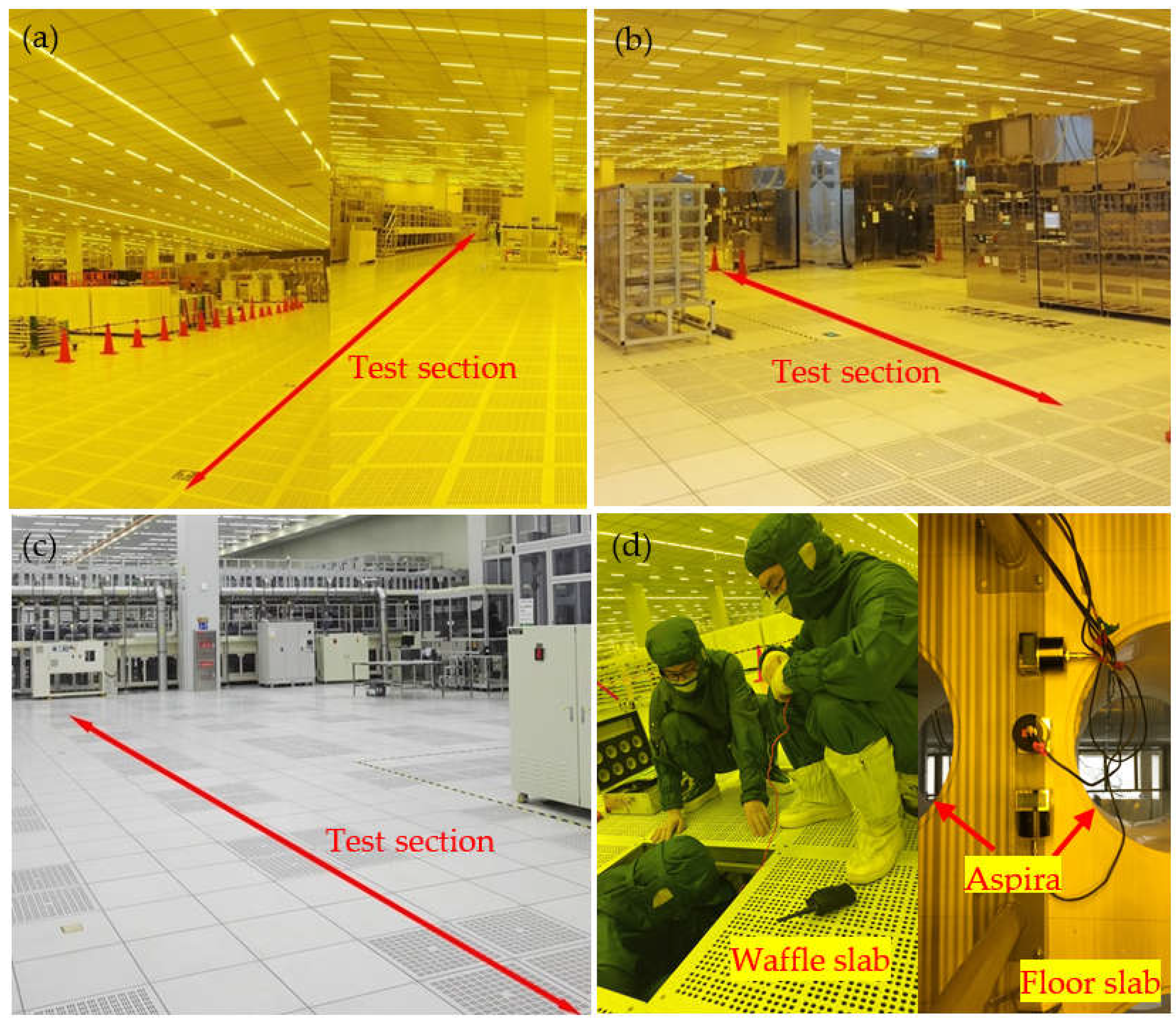
Figure 4.
Installation of sensors on test section 4 #.
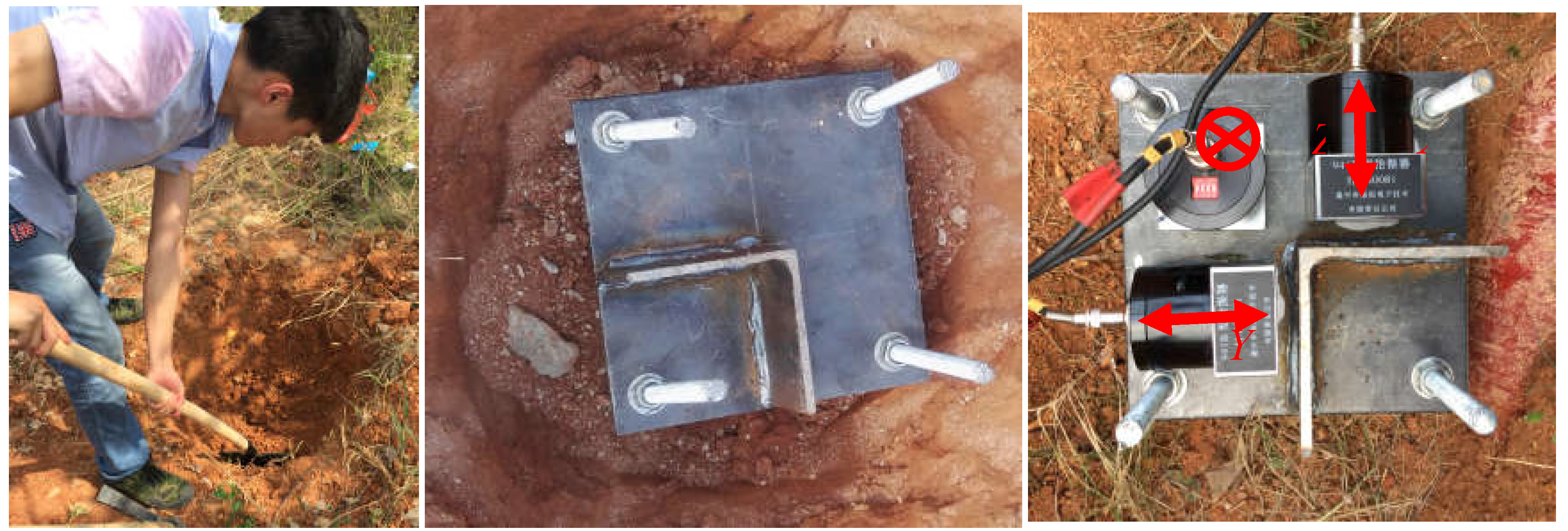
Figure 5.
Vehicles on the urban expressway beside the workshop.
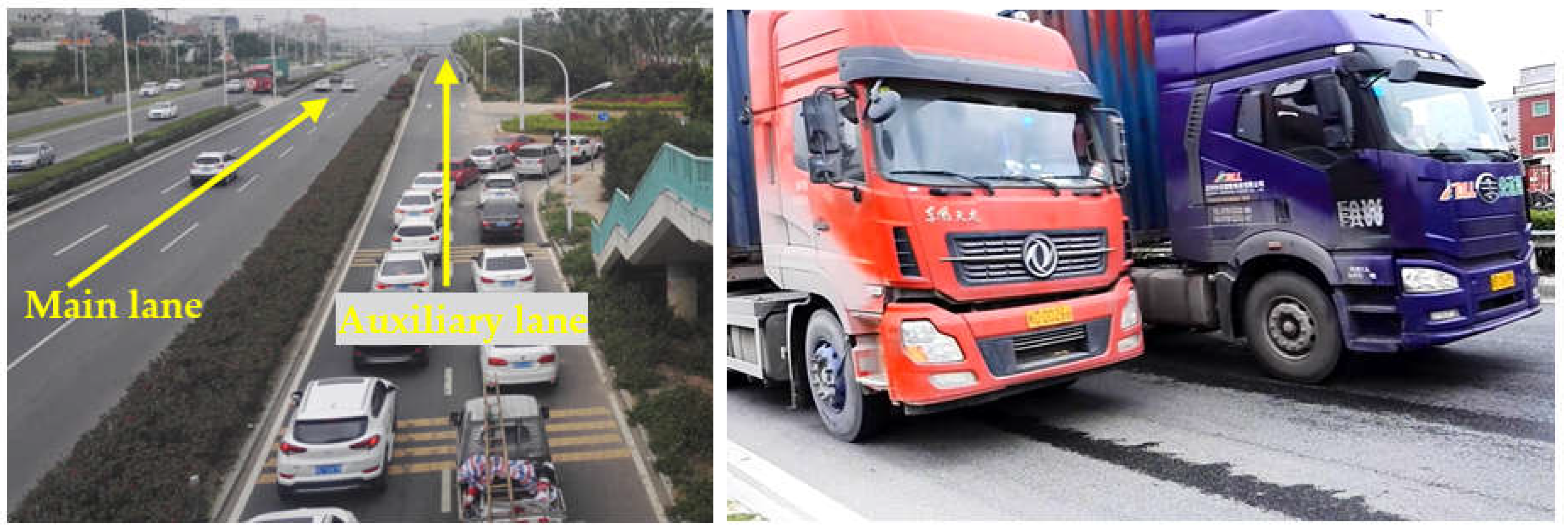
Figure 6.
Time histories of vibration velocity at test section 4 # in: (a) vertical direction; (b) X direction; and (c) Y direction.
Figure 6.
Time histories of vibration velocity at test section 4 # in: (a) vertical direction; (b) X direction; and (c) Y direction.
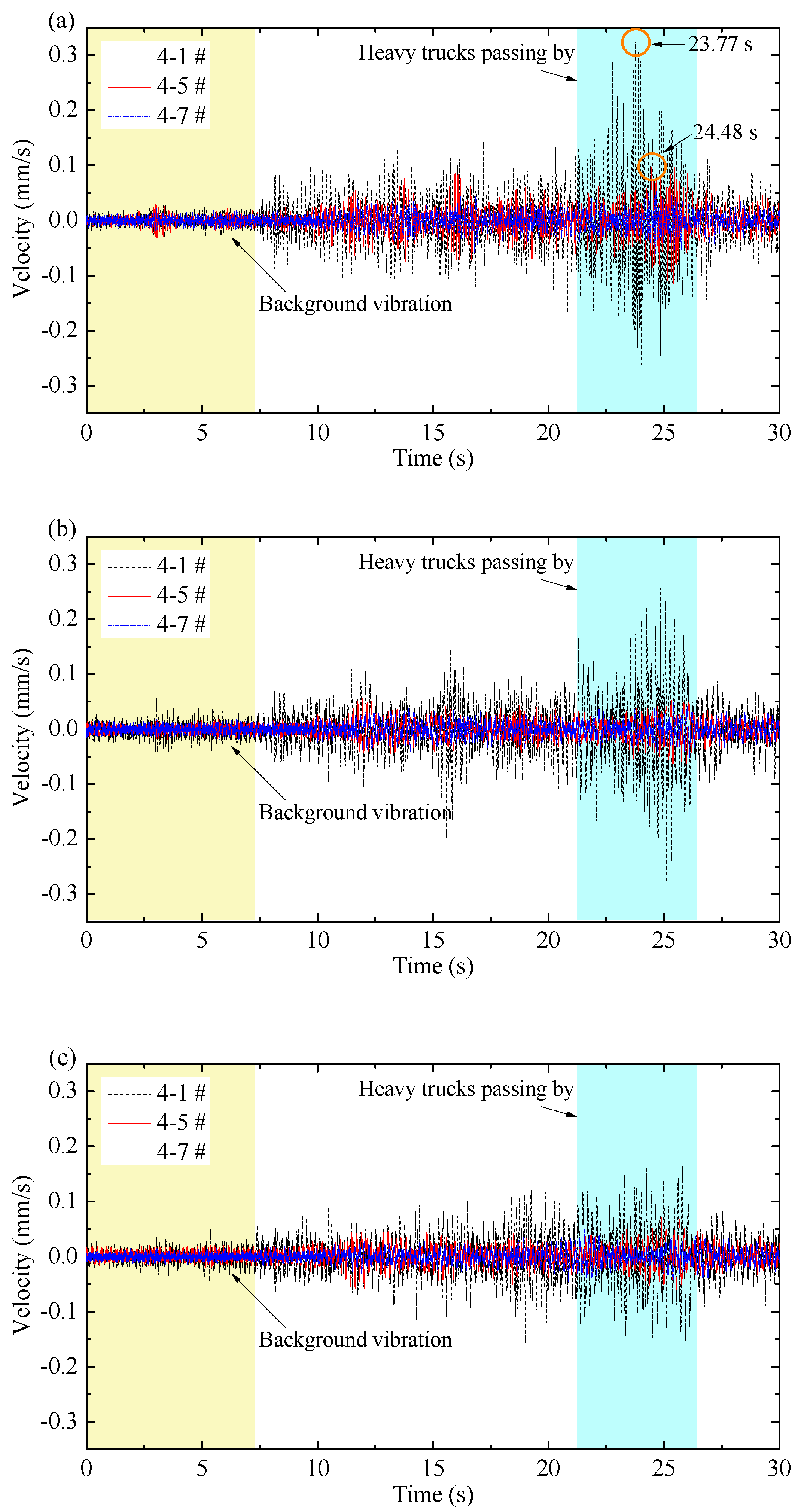
Figure 7.
Spectra of vibration velocities at test section 4 # in: (a) vertical direction; (b) X direction; and (c) Y direction.
Figure 7.
Spectra of vibration velocities at test section 4 # in: (a) vertical direction; (b) X direction; and (c) Y direction.
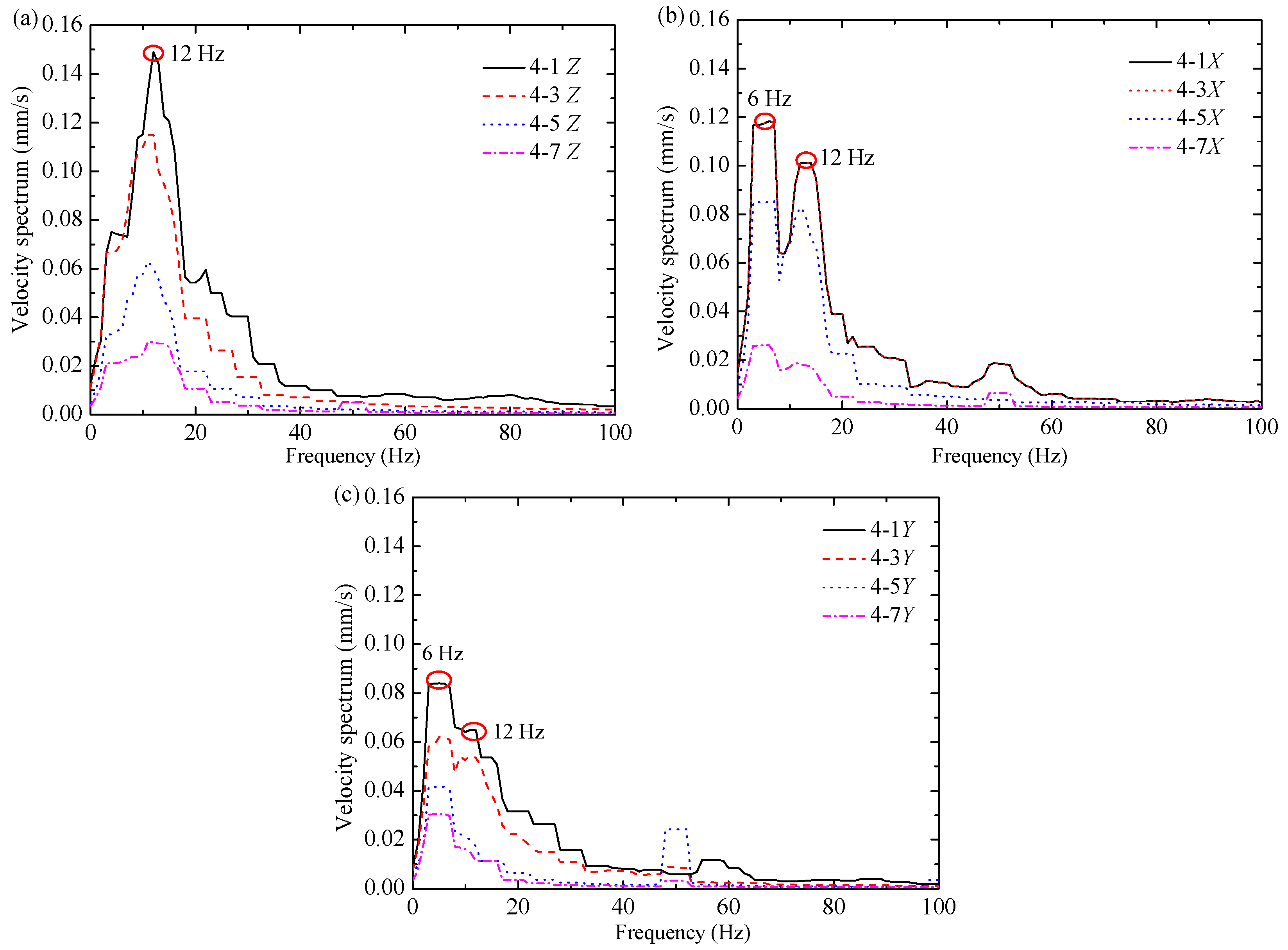
Figure 8.
1/3 octave spectra of vertical velocity at test points of (a) 4-1 #; (b) 4-3 #; (c) 4-5 # and (d) 4-7.
Figure 8.
1/3 octave spectra of vertical velocity at test points of (a) 4-1 #; (b) 4-3 #; (c) 4-5 # and (d) 4-7.

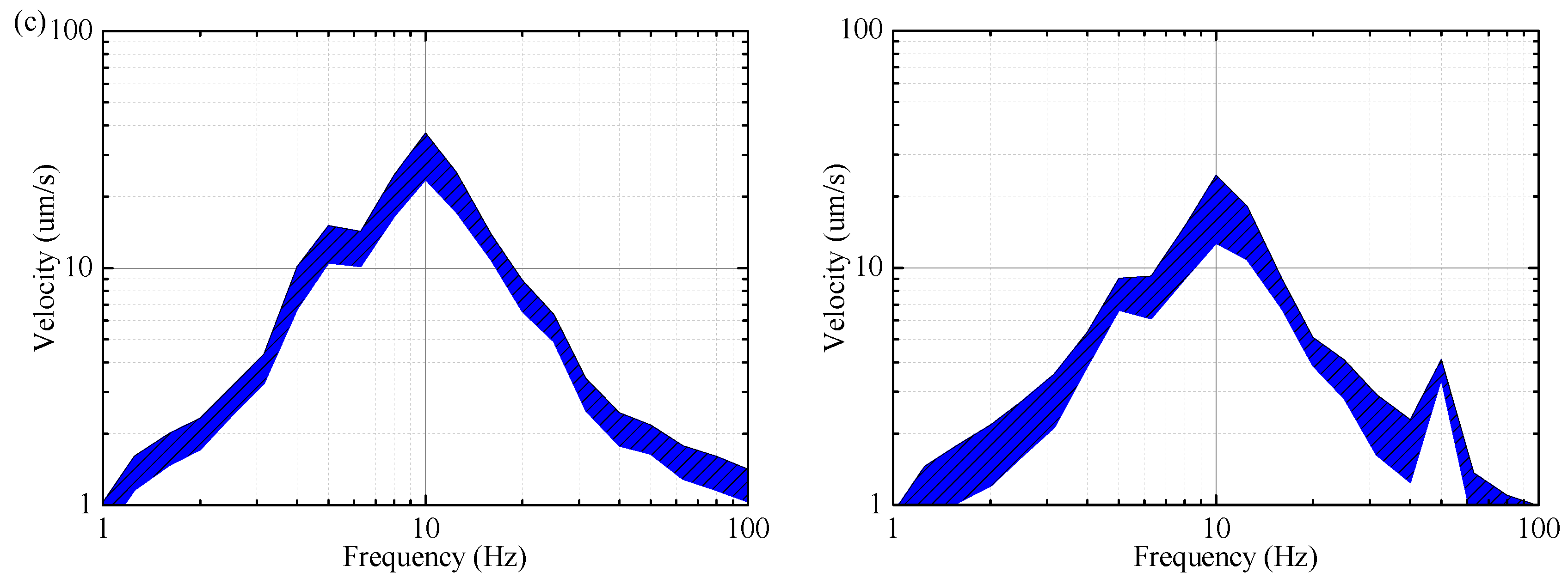
Figure 9.
Vertical velocity levels of test points from 4-1 # to 4-7 # at test section 4.
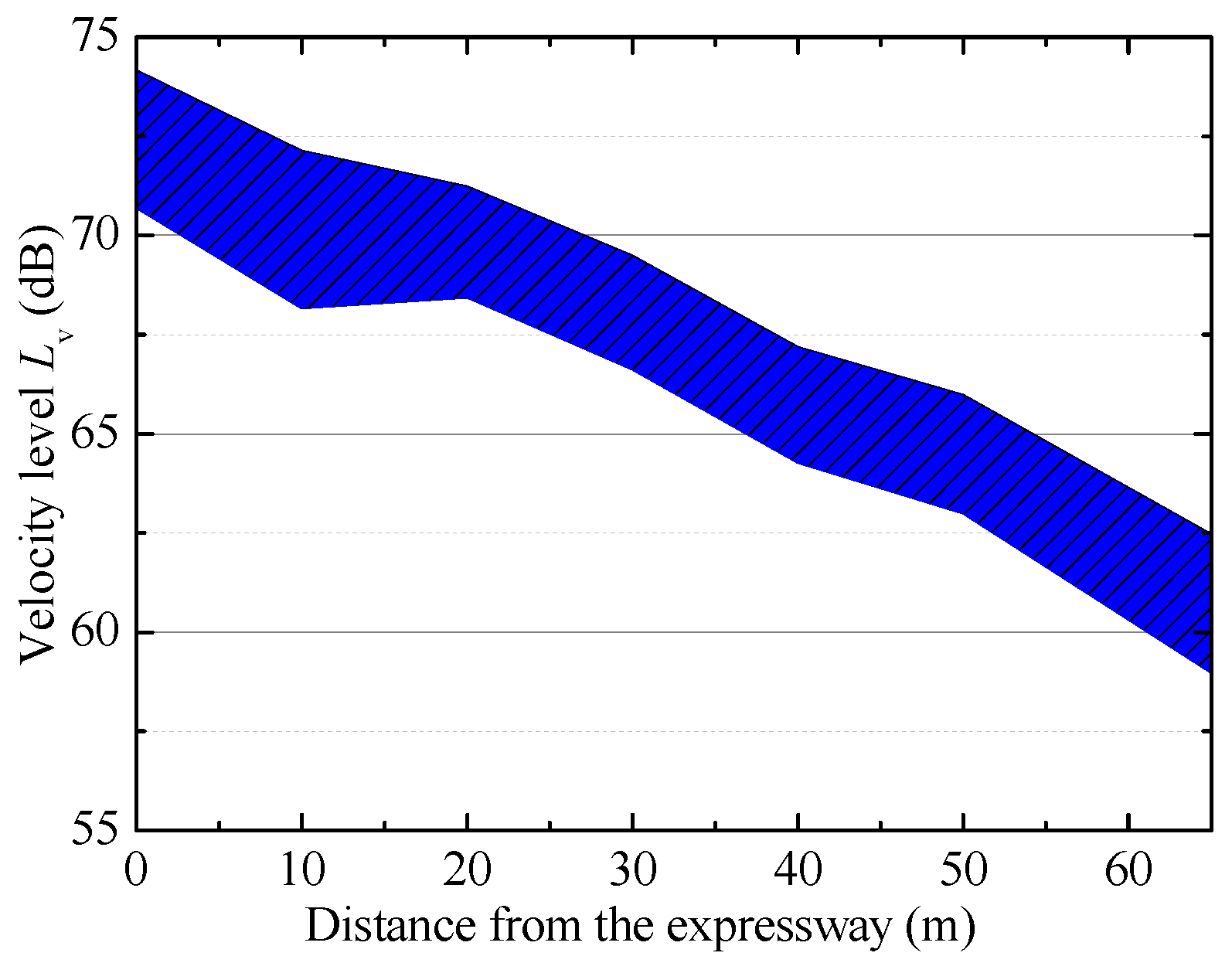
Figure 10.
Time histories of vertical vibration at test points of 2-4 # and 2-8 #: (a) First floor and (b) second floor.
Figure 10.
Time histories of vertical vibration at test points of 2-4 # and 2-8 #: (a) First floor and (b) second floor.
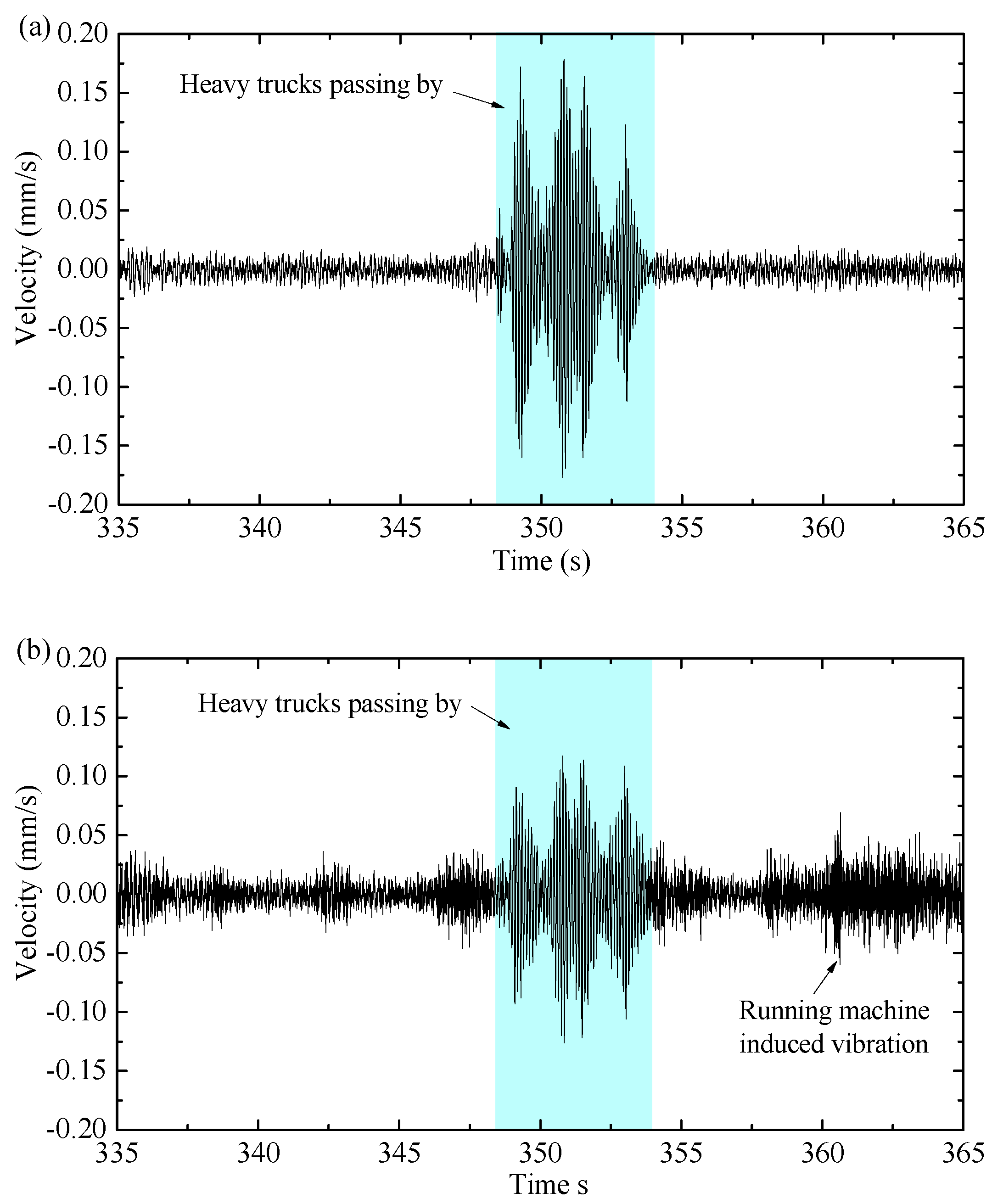
Figure 11.
Spectra of vertical vibration at test section 2 # on the: (a) first floor and (b) second floor.
Figure 11.
Spectra of vertical vibration at test section 2 # on the: (a) first floor and (b) second floor.
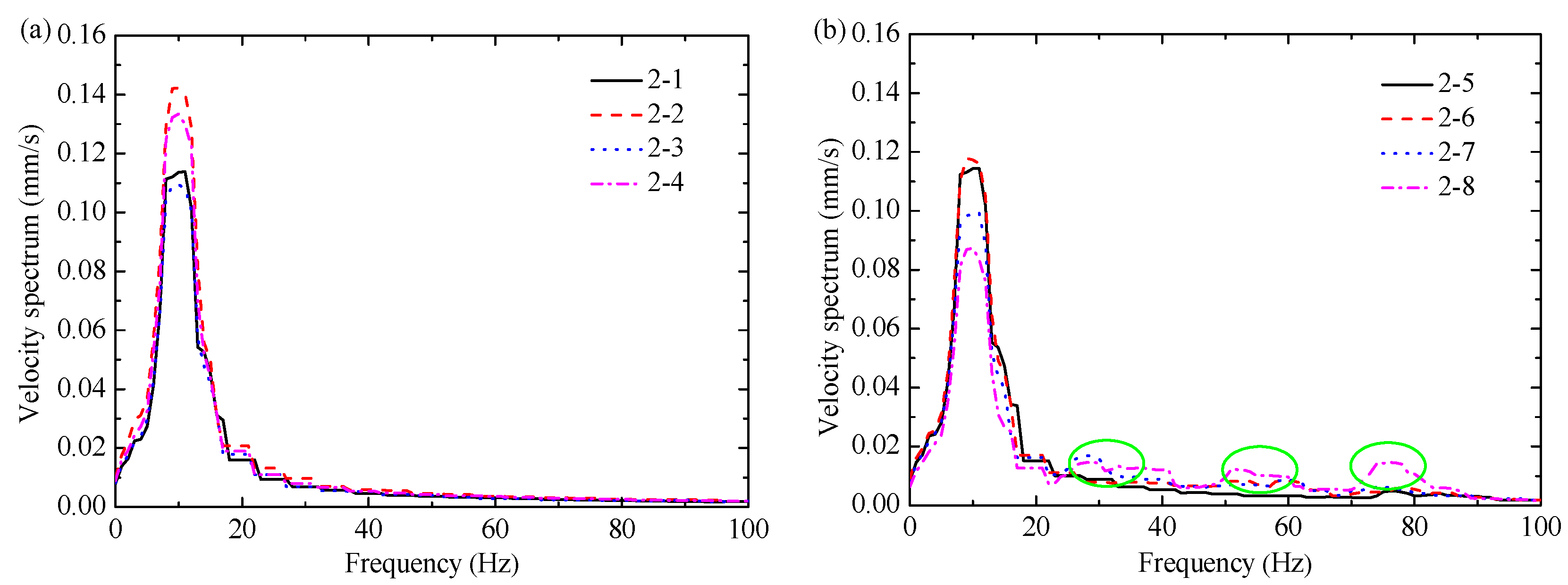
Figure 12.
VC standard in 1/3 octave [30].
Figure 12.
VC standard in 1/3 octave [30].
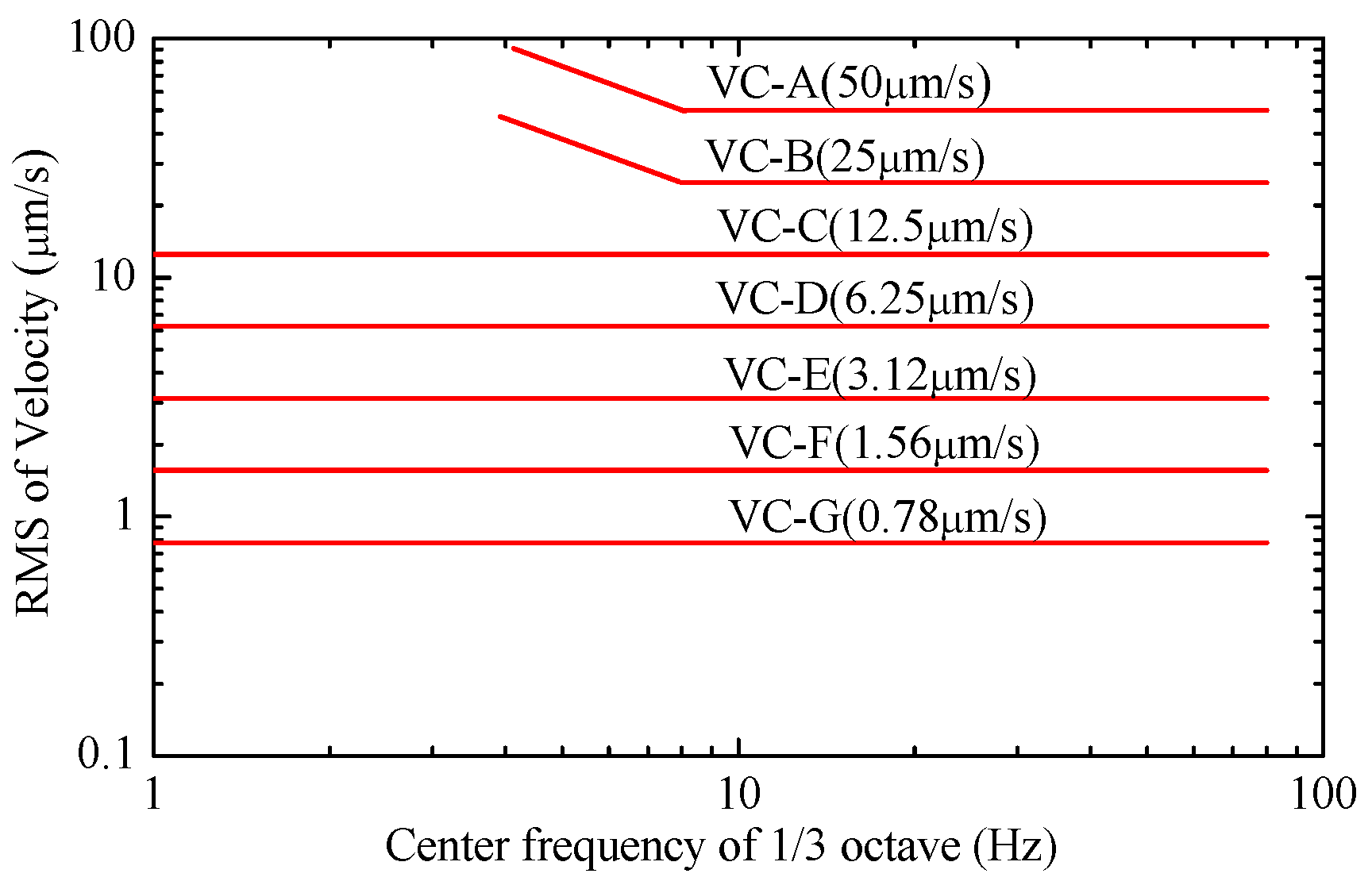
Figure 13.
1/3 octave spectra of vibration velocities in the vertical direction: (a) on the first floor in the daytime; (b) on the second floor in the daytime; (c) on the first floor at night; and (d) on the second floor at night.
Figure 13.
1/3 octave spectra of vibration velocities in the vertical direction: (a) on the first floor in the daytime; (b) on the second floor in the daytime; (c) on the first floor at night; and (d) on the second floor at night.
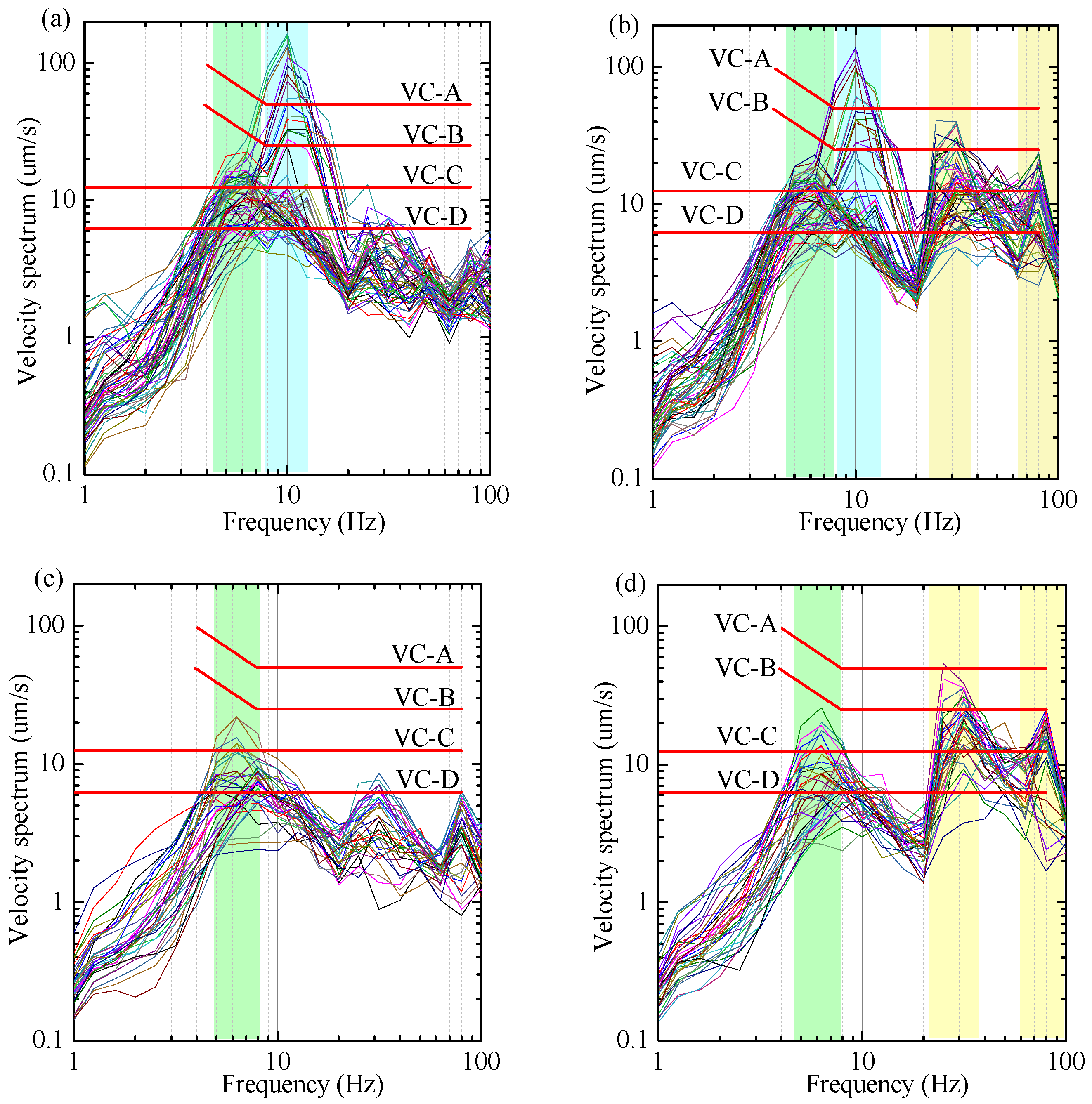
Figure 14.
1/3 octave spectra of vibration velocity in the X direction: (a) on the first floor in the daytime; (b) on the second floor in the daytime; (c) on the first floor at night; and (d) on the second floor at night.
Figure 14.
1/3 octave spectra of vibration velocity in the X direction: (a) on the first floor in the daytime; (b) on the second floor in the daytime; (c) on the first floor at night; and (d) on the second floor at night.

Figure 15.
1/3 octave spectra of vibration velocity in the Y direction: (a) on the first floor in the daytime; (b) on the second floor in the daytime; (c) on the first floor at night; and (d) on the second floor at night.
Figure 15.
1/3 octave spectra of vibration velocity in the Y direction: (a) on the first floor in the daytime; (b) on the second floor in the daytime; (c) on the first floor at night; and (d) on the second floor at night.

Figure 16.
Vertical vibration levels of the workshop during one day at (a) test section 1#; (b) test section 2#; and (c) test section 3#.
Figure 16.
Vertical vibration levels of the workshop during one day at (a) test section 1#; (b) test section 2#; and (c) test section 3#.
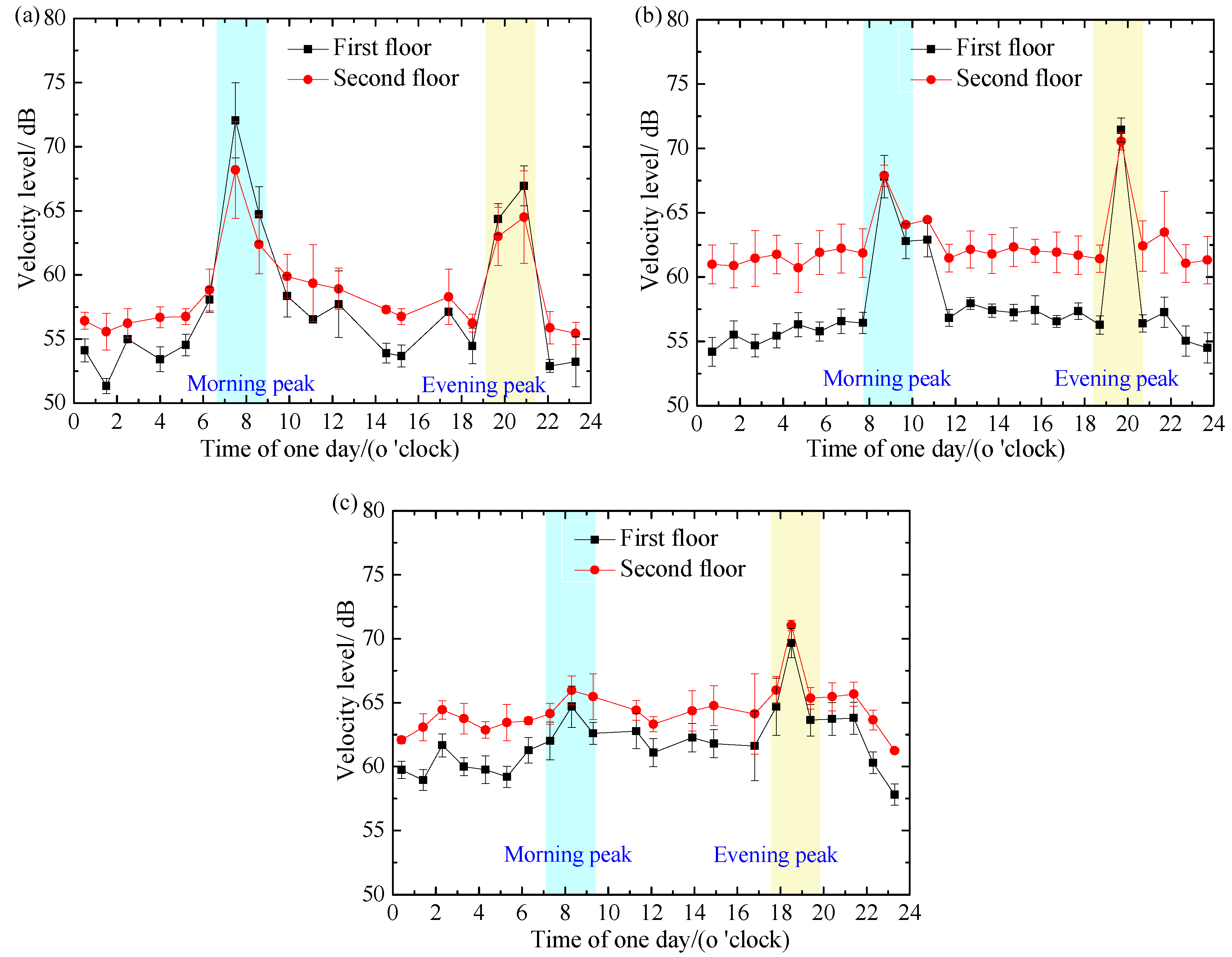
Disclaimer/Publisher’s Note: The statements, opinions and data contained in all publications are solely those of the individual author(s) and contributor(s) and not of MDPI and/or the editor(s). MDPI and/or the editor(s) disclaim responsibility for any injury to people or property resulting from any ideas, methods, instructions or products referred to in the content. |
© 2023 by the authors. Licensee MDPI, Basel, Switzerland. This article is an open access article distributed under the terms and conditions of the Creative Commons Attribution (CC BY) license (http://creativecommons.org/licenses/by/4.0/).
Copyright: This open access article is published under a Creative Commons CC BY 4.0 license, which permit the free download, distribution, and reuse, provided that the author and preprint are cited in any reuse.
Measurements on Micro-Vibration in a Production Workshop with Precision Instruments Induced by Road Traffic
Zhijun Zhang
et al.
,
2023
Experimental Study of the Train-Induced Vibration Propagation on Over-Track Buildings over Metro Depots
Yang Liu
et al.
,
2023
Development of the New Method for Assessing Condition of Forest Road Surface
Marijan Šušnjar
et al.
,
2018
MDPI Initiatives
Important Links
© 2024 MDPI (Basel, Switzerland) unless otherwise stated








